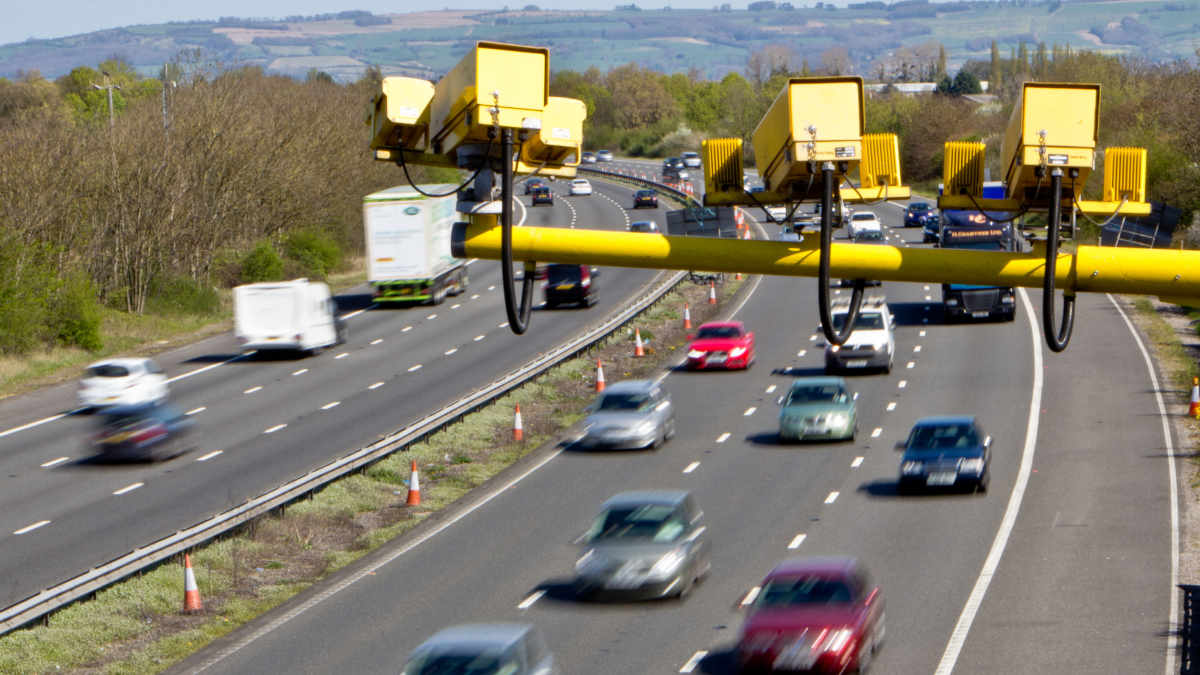Speed cameras are often viewed as a bane to motorists but in fact, speed cameras cut road accidents and reduce injuries caused by driving over the speed limit. One in three drivers faces a speeding fine each year, according to the RAC for driving over the speed limit. Understanding speed cameras, how they work, and the types of speed camera used, can help you to moderate your driving, and even appeal a speeding fine if you’re caught speeding.
Most speed cameras are actively used. According to a BBC report around 52% of speed cameras are in active use across the UK. A total of 36 police forces responded to a freedom of information request, which found that of the 2,838 speed cameras used by the police forces, 1,486 were active. This means that if you drive past a speed camera at speeds higher than the stated limit, there’s roughly a 50:50 chance you’ll be caught. However, some types of speed camera may be more active than others.
Caught speeding? Read our free guide to speeding fines – speeding tickets explained to find out how much you might have to pay and how you can appeal a speeding ticket.
Speed cameras – different types of speed camera
There are around 20 different types of speed cameras in operation across the UK’s 40 police forces, made up of fixed speed cameras, mobile speed cameras and average speed cameras. For speed camera enthusiasts, there is lots of detail about each model of speed camera at Speedcamerasuk.com. However, we’ve gathered together information on the three types of speed camera you’ll most likely to encounter, including how they work.
Fixed speed cameras
Fixed speed cameras are the most visible on UK roads. Catching a glimpse of the bright yellow camera housing along with a flash in your rearview mirror may mean you’ve been caught speeding. They’re usually positioned above the road on gantries or on a pole at the side of the road, angled down to view all lanes. Painted lines on the adjacent road are used by the police to determine if your car was above the speed limit.
Fixed speed cameras rely on radar to determine the speed of your car, which means they work in all weather. Using radar, they constantly ping traffic and if you’re driving faster than the speed limit, the camera will take two photos in quick succession. By comparing the position of your car and how far it has travelled over the painted lines between the time the two photos were taken, the speed you were driving at can be determined.
By law, fixed speed cameras need to be visible – bright yellow boxes have replaced the less-than-visible dull grey of previous models – and sign-posted. You should be aware that you are on a stretch of road with speed cameras. They can trigger at 1mph above the stated speed limit, but police forces typically allow a leeway of 10% above the limit before you get a Fixed Penalty Notice, a fine at £100 and three points.
There are several types of fixed speed camera including:
Gatso speed cameras – The most common type of fixed camera, and usually deployed at accident blackspots. First introduced in 1992, the Gatso is a rear-facing speed camera that photographs a car’s rear number plate. Characterised by their bright yellow housing, the previous models used film which often meant they ran out. Newer models introduced in the past ten years take digital photos, meaning they can keep on capturing speeding cars. They work by beaming radar at passing cars and measuring the time it takes to bounce back to determine its speed. Two photos are taken with the lines on the road used as evidence to show how fast a car was travelling.
Truvelo speed cameras – A more modern fixed speed camera, it can be used to take photos of the front of a car, including a photo of the driver. Unlike a Gasto, it doesn’t have a flash, so you can’t always tell if you were caught speeding. Rather than painted lines, it uses embedded sensors in the road to determine the speed of a car before taking photos digitally and sending them wirelessly to the police force. Common in Hampshire and Northamptonshire, they’re harder to avoid as there are no painted lines on the road and no tell-tale camera flash to alert road users.
Hadecs 3 speed camera – Labelled as a stealth camera, the Hadecs 3 dispenses with the yellow housing in favour of a small, grey box, which makes it hard to spot. It’s used as part of the smart highways upgrades on major parts of the UK’s motorway network, including the M20 in Kent, M25 in Kent and Surrey, M1 in Derbyshire, M6 in Staffordshire and the M4/M5 in Somerset. Hadecs 3 cameras are popular with police forces so expect them to roll out to other motorways. You can spot them mounted on poles by the side of motorways or on overhead gantries. They are very accurate, and some reports claim they have a hair-trigger, often activating at 1mph above the limit. They are usually active to enforce speed restrictions changes on overhead gantry LED signs during congestion.
Average speed cameras
Usually found on sections of a motorway and dual carriageway that has roadworks, average speed cameras are exactly that. Positioned along a stretch of road, they take photos of your number plate as you pass, using Automatic Number Plate Recognition (ANPR) to convert the data into data. By measuring how long it takes you to travel over a set distance, these cameras work out your average speed and – if above the posted limit – issue a Fixed Penalty Notice.
Unlike Gatso, there are no camera flashes and they’re entirely digital, meaning they’re active 24 hours a day. There are five main models of average speed camera:
SPECS speed camera – Able to measure your speed over a distance of up to 10kms, they’re mounted on gantries and can monitor up to four lanes of the motorway at once. They use infrared to work at night and all photos are taken with a date and time stamp. If you’re travelling over the average speed limit, you’ll be automatically issued an FPN.
Siemens SafeZone speed camera – These digital cameras measure the speed a car travels between two cameras, using ANPR to record details from a photograph of a car number plate. They are distinctive in their small size, making them easier to deploy away from motorways and roadworks. Increasingly, SafeZone cameras are appearing to enforce inner-city 20mph zones, especially around schools. They’re also rolling out across London.
SpeedSpike speed camera – If the manufacturer’s claims are true, the SpeedSpike could, in theory, measure your average speed from Land’s End to John O’Groats if installed along the route. Working wirelessly, up to 1,000 SpeedSpike cameras can be linked together, sharing data such as your number plate seamlessly between them. They work similarly to other average speed cameras and are fully automatic, working 24 hours a day.
Vector speed camera – A newcomer to the average speed camera world, having launched in 2014. It can be used as a kind of multi-role camera, including average speed, enforcing bus lanes, toll roads and anything requiring ANPR technology.
Mobile speed cameras
Unlike fixed or average speed cameras, it can be impossible to spot a mobile speed camera. Deployed by police forces, they can appear in a certain location without warning. They can be used by a single traffic enforcement police officer using a handheld speed camera or positioned in vans that are either parked in laybys or parked on bridges over sections of motorway. They are also used in residential areas to enforce the 30mph limit.
Radar mobile speed cameras – These use radar to bounce a signal off a speeding car and have a range of around 300 yards making them a favourite for use in residential areas. It takes around three seconds for the mobile camera to lock onto and record the speed of a car.
Laser mobile speed cameras – Faster and with greater range than radar-based mobile speed cameras. These use laser beams that are just 10cm wide but allow them to reach a distance of around one mile – making them effective on fast traffic such as motorways. The speed to lock on and record the speed of a vehicle is swift, too, at less than one second.
Best-selling speed camera detectors
Stuck for inspiration? Check out our list of best-selling Amazon products!
- Avoid fines: Saphe Drive Pro utilises one of the largest traffic communities in the Europe, reliably warning you about upcoming speed cameras and hazards across Europe
- Easy use: The large and intuitive 1.54-inch display provides in-depth traffic detail with colourful symbols and sounds, displaying speed limits and upcoming traffic lights
- Stay connected: The Saphe Link App Connects to Apple CarPlay and Android Auto, linking your information to a large dashboard display
- EMPOWERED INFORMED DECISIONS - With UK speeding fines and variable speeding limits on the increase nationwide, make sure you get a clear view of the road ahead and never miss a speed camera again with...
- SMART MOTORWAY READY - Make sure you’re ready for the Smart Motorway revolution. Our speed camera/radar detectors give live updates and GPS location information. With built-in laser gun protection...
- BUILT-IN GPS LOCATOR & LASER GUN PROTECTION - Our speed camera and radar detectors give live updates and information based on GPS location, with built-in laser gun protection to guarantee the...
- SPEED LIMIT & SPEED CAMERA ALERTS - Snooper Aura speed trap database alerts drivers to the location of all types of GPS speed cameras including Gatso, Truvelo, Specs and Watchman across the UK and...
- SPEED CAMERA ALERT SYSTEM - Includes: MY SPEED XL G2, Power lead with 12/24v accessory socket adaptor, Suction Cup Windscreen Bracket
- 5” LCD COLOUR SCREEN - The large display ensures you can easily see information on the screen, with the speed limit displayed on the right and your speed limit on the left. If you’re driving above...
- Avoid fines: Saphe Drive Pro utilises one of the largest traffic communities in the Europe, reliably warning you about upcoming speed cameras and hazards across Europe
- Stay safe: The intuitive colour display warns when it matters with easy-to-read symbols that indicate traffic and camera data, while simultaneously giving a precise indication of their distances
- Automatic start: Download the Saphe Link app and automatically connect to the device through Bluetooth every time you approach your car.
Last update on 2024-04-03 / Affiliate links / Images from Amazon Product Advertising API
You may be interested in…
This article may include affiliate links to products and services where we may receive a small fee to support the running of this site if you make a purchase or is a sponsored article from one of our select editorial partners providing valuable advice and information to our readers.




































































